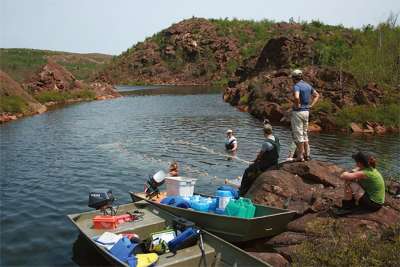
We don’t typically think of forest debris as a food source for freshwater fish and other aquatic organisms, but a study by researchers at the University of Cambridge in England suggests that it plays a key role in their diets. The research team, led by plant scientist Andrew Tanentzap, studied the ecosystem at Daisy Lake in Sudbury, Ontario, and found that fish in areas where leaves and other forest debris drained into the lake were fatter than fish in areas receiving no forest debris.
According to Tanentzap, forest debris is an important contributor to freshwater food chains, supplementing the diets of microscopic zooplankton and the fish that feed upon them. His research was published last year in the journal Nature Communications.
Tanentzap studied young yellow perch at several sites around the lake with varying degrees of forest coverage, including an area denuded of forest from an old nickel smelting operation. Carbon from forest debris has a different elemental mass than carbon from algae in the aquatic food chain, so he was able to determine that at least 34 percent of the fish biomass came from forest vegetation, increasing to 66 percent in areas surrounded by healthy forest.
He said that the more forest around the edge of the lake, the fatter the fish were. Fish in areas of scant forest cover were considerably smaller and less likely to survive and breed. The young fish near the smelting operation were the smallest of them all, due to a shortage of food. They were also more susceptible to poor health and predation.
“We found fish that had almost 70 percent of their biomass made from carbon that came from trees and leaves instead of aquatic food chain sources,” he said. “While plankton raised on algal carbon is more nutritious, organic carbon from trees washed into lakes is a hugely important food source for freshwater fish, bolstering their diets to ensure good size and strength.”
Tanentzap said that when detritus from forest foliage travels from fast-moving streams into the slow-moving lake, it sinks and forms layers of sediment. “Where you have more dissolved forest matter you have more bacteria. More bacteria equals more zooplankton. And areas with the most zooplankton had the largest fattest fish,” he said.
The research was conducted in a boreal ecosystem where ancient forests are vital to the Earth’s carbon cycle. Tanentzap warned that the loss of forest debris due to the erosion of these forests from human activity is likely to have a negative effect on the health of aquatic organisms. He noted that more than 60 percent of the world’s fresh water is in boreal areas. These areas are suffering from human disturbance, such as logging and mining, and from an increase in forest fires which many scientists believe are caused by climate change – all occurrences that are predicted to intensify in coming years.
“While we’ve only studied boreal regions, our results are likely to bear out globally,” he concluded. “Forest loss is damaging aquatic food chains.”

